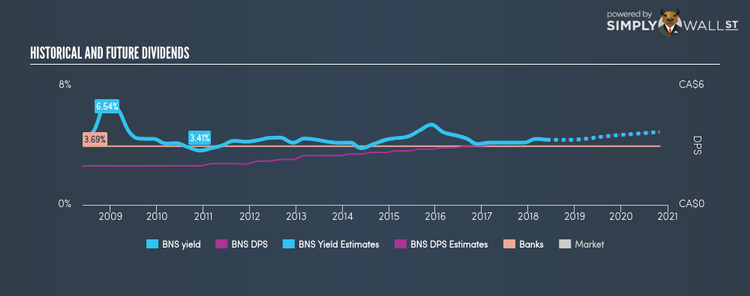Are You An Income Investor? Don’t Miss Out On The Bank of Nova Scotia (TSE:BNS)

Over the past 10 years The Bank of Nova Scotia (TSX:BNS) has returned an average of 4.00% per year from dividend payouts. The stock currently pays out a dividend yield of 4.09%, and has a market cap of CA$96.23B. Does Bank of Nova Scotia tick all the boxes of a great dividend stock? Below, I’ll take you through my analysis. See our latest analysis for Bank of Nova Scotia
Here’s how I find good dividend stocks
Whenever I am looking at a potential dividend stock investment, I always check these five metrics:
Does it pay an annual yield higher than 75% of dividend payers?
Has it paid dividend every year without dramatically reducing payout in the past?
Has it increased its dividend per share amount over the past?
Is it able to pay the current rate of dividends from its earnings?
Will the company be able to keep paying dividend based on the future earnings growth?
Does Bank of Nova Scotia pass our checks?
The current trailing twelve-month payout ratio for the stock is 45.30%, which means that the dividend is covered by earnings. In the near future, analysts are predicting a payout ratio of 45.93%, leading to a dividend yield of 4.25%. Furthermore, EPS should increase to CA$7.14. If there is one thing that you want to be reliable in your life, it’s dividend stocks and their constant income stream. In the case of BNS it has increased its DPS from CA$1.88 to CA$3.28 in the past 10 years. During this period it has not missed a payment, as one would expect for a company increasing its dividend. This is an impressive feat, which makes BNS a true dividend rockstar. Relative to peers, Bank of Nova Scotia produces a yield of 4.09%, which is high for Banks stocks but still below the market’s top dividend payers.
Next Steps:
Keeping in mind the dividend characteristics above, Bank of Nova Scotia is definitely worth considering for investors looking to build a dedicated income portfolio. Given that this is purely a dividend analysis, I urge potential investors to try and get a good understanding of the underlying business and its fundamentals before deciding on an investment. There are three important aspects you should further research:
Future Outlook: What are well-informed industry analysts predicting for BNS’s future growth? Take a look at our free research report of analyst consensus for BNS’s outlook.
Valuation: What is BNS worth today? Even if the stock is a cash cow, it’s not worth an infinite price. The intrinsic value infographic in our free research report helps visualize whether BNS is currently mispriced by the market.
Other Dividend Rockstars: Are there better dividend payers with stronger fundamentals out there? Check out our free list of these great stocks here.
To help readers see pass the short term volatility of the financial market, we aim to bring you a long-term focused research analysis purely driven by fundamental data. Note that our analysis does not factor in the latest price sensitive company announcements.
The author is an independent contributor and at the time of publication had no position in the stocks mentioned.

 Yahoo Finance
Yahoo Finance 
